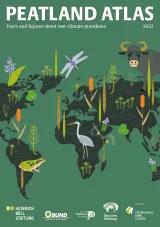
From lowland swamps dominated by tall palms to the treeless cushion bogs of the high Andes, Latin America and the Caribbean are home to a huge range of peatlands. But relatively little is known about them – making conservation difficult.

Latin America and the Caribbean have a wide range of peatland types: palm and freshwater swamps, mangroves, a variety of forests, shrublands and grasslands, and moss and cushion peatlands in high Andean mountains. They vary in their appearance, dominant vegetation, and main source of water. They are home to unique plants, shelter rare, endemic and endangered animal species, and provide resting and breeding sites for migratory birds. Lowland Amazonian peatlands host particularly high levels of regional species diversity.
The region’s peatlands also supply products for local consumption and trade: fruits, flowers, leaf fronds and fibres, building materials and honey. Aguaje palms in the Amazon swamps produce fruit for eating or for processing into drinks, ice cream or oil. They are an important source of income for many families in rural areas of Peru and in the city of Iquitos on the Amazon. Herders in the Andes and Patagonia use peatlands known as bofedales as pasture for the native alpacas and llamas, as well as for sheep, cattle and horses. The peatlands are also an important source of water for several large cities and for agriculture.
More than 3 percent of the region’s peatlands are degraded. Throughout the region, and especially in Central America and the Caribbean, peatlands are drained for cultivation or pasture. Peat is also extracted for commercial use, particularly for horticulture. While in some countries such as Peru, the peat is dug on a small scale by informal businesses, in Chile and Argentina, peat and peat moss are extracted on a larger scale from pristine peatlands. This industry is regulated by mining policies and is a growing threat. In Chile, the exportation of dry Sphagnum fibre has increased four-fold between 2001 and 2019, to 4,615 tons worth 21 million US Dollars.
The greenhouse gas emissions from drained peatlands in Latin America and the Caribbean are estimated at 91 million tonnes of carbon dioxide equivalent per year. Yet few countries have policies that specifically address peat or peatlands and their conservation and restoration. Argentina, for example, has designated specific areas for peatland conservation. Peru banned the commercial peat extraction in 2021, allowing only traditional and domestic use. Ecuador has a water fund that conserves and rewets high-altitude peatlands. But other countries allow, or even encourage, the draining of wetlands for agriculture, especially for sugarcane, bananas, palm oil and rice, or for urban growth, as in Brazil, Cuba, Mexico, Panama and Peru. Drainage is not the only threat. Other drivers of change include the extraction of oil, gas and peat for fuel, overgrazing, mining, fires and climate crisis. New concessions for oil and gas, hydropower, logging and palm oil may outstrip current threats.
Research on peatlands in the region is still in its early stages, so knowledge and data are scarce. Many governments are unaware of the presence or importance of peatlands within their borders. There are several reasons for this lack of awareness: the history of colonialism, the lack of common terms and classifications, and the diversity of peatlands complicates their recognition. In addition, in many countries only few scientific institutions conduct research on the subject. Most peat research is carried out by foreign institutions, so linguistic or cultural barriers can hinder the spread of information and hamper conservation, restoration and sustainable management efforts. A lack of governance and regulation are common challenges, as are corruption and poverty. However, Indigenous and local communities have traditional knowledge of how to manage water, grasslands and livestock, and how to use resources and manage peatlands in a sustainable way.
The situation of the peatlands in the Peruvian Amazon is an example of what can happen when the existence and value of peatland ecosystems are recognized. Policies had put peatlands on a path of extractive use, neglecting their value in storing carbon and providing ecosystem services. This began to change in the last years, when the extent and importance of tropical peatlands in Latin America were recognized, leading to growing national and international interest, and to initiatives in research, sustainable management and conservation. Traditional knowledge about the classification and use of these ecosystems is now being studied, and the strong spiritual connection of Indigenous peoples to peatlands is being recognized. The Peruvian government now acknowledges the importance of peatlands as a carbon sink. While the situation in Peru has improved, much more needs to be done in terms of research and policymaking there and in other countries in the Amazon basin to ensure that the peat there is protected.

